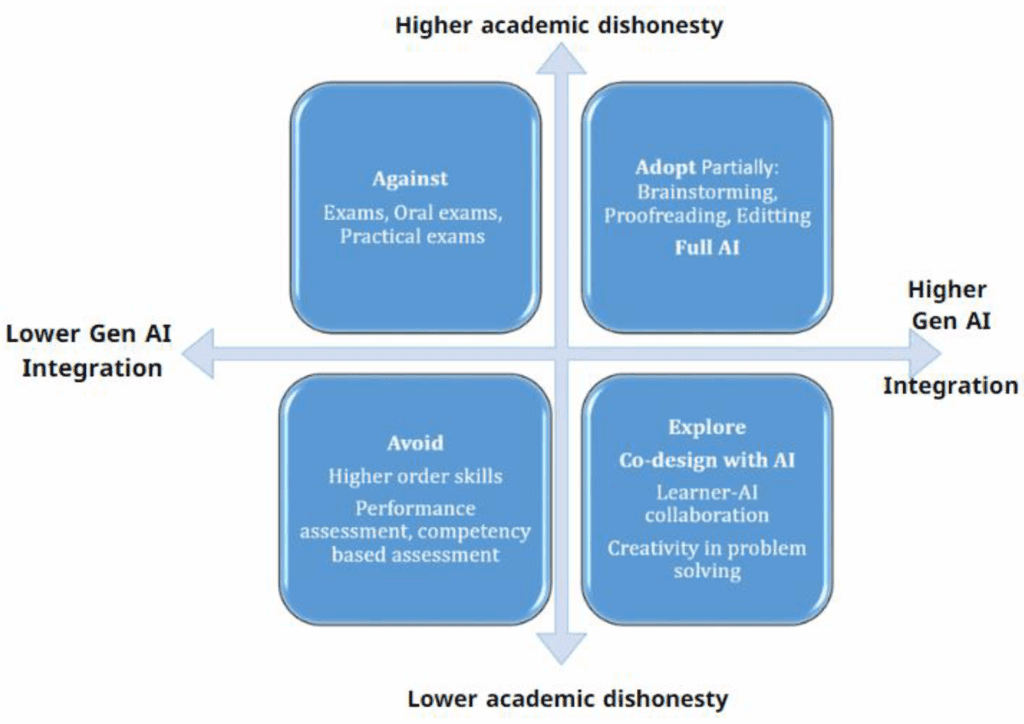Human-Centred Design in Education
Human-centred design (HCD) is a philosophy and practice of design that utilizes a holistic viewpoint, placing humans at the core of every consideration (Norman, 2013, 2016). It recognizes a complex, interconnected system and seeks to benefit the system as a whole, acknowledging that optimization of the local does not always benefit the whole (Norman, 2016). The people involved form the fundamental considerations within this system—from end users to stakeholders, fabricators, designers, and beyond (Norman, 2016). In HCD, every individual is affected by design (Norman, 2016).
“The philosophy and procedures of HCD add deep consideration and study of human needs to the design process” (Norman, 2013, p. 9).
Education, like HCD, should hold the people involved as the focus. Specifically, the whole person should be considered, beyond simply the educational content, as emotions and motivations are the gatekeepers of learning (Dumont et al., 2010). Often, the broad scope of educational design can obscure the human element and/or focus on a part of the system to the detriment of the whole. HCD demands that humans remain the foremost priority while considering a holistic perspective of the educational system.
(Norman, 2018)
Human-Centred Design, Generative Artificial Intelligence, and Education
“Good design starts with an understanding of psychology and technology” (Norman, 2013, p. 8).
In contemplating the role of generative artificial intelligence (GenAI) with education through the lens of HCD, we must first consider the fundamental psychological concepts of interaction which apply to GenAI: affordances, signifiers, and the conceptual model of the system (Norman, 2013), and then place GenAI within the educational system. A thorough evaluation of GenAI through this lens could be subject to an entire book so I will only touch the surface. Before exploring GenAI further, it is crucial to clarify what I mean by the term. Drawing on Suchman’s (2023) definition, GenAI refers to “a label for currently dominant computational techniques and technologies that extract statistical correlations (designated as patterns) from large datasets, based on the adjustment of relevant parameters according to either internally or externally generated feedback” (p. 2).
Affordances
“Affordances represent the possibilities … for how an agent (a person, animal, or machine) can interact with something” (Norman, 2013, p. 18)
GenAI can instantly generate personalized content across multiple media forms including text, images, audio, and video based on an external prompt. Humans that directly engage with GenAI-tools can be understood as participating in distributed cognition—a human-GenAI collaboration in creating content. These affordances of GenAI may foster an expectation across the broader media ecology for instant, personalized content, that is in constant interplay and evolution from external influences.
Signifiers
“Signifiers signal things, in particular what actions are possible and how they should be done” (Norman, 2013, p. 19)
GenAI invites anthropomorphizing, the attribution of human characteristics, through its speed and contextualization. The rapid responsiveness of GenAI to an input may signal an ongoing reactivity, reflecting a continuous interplay, while the content produced by GenAI can span a vast range of topics developing an illusion of intelligence, thinking, and/or understanding. Interactions with GenAI resemble a human-human, co-created experience prompting humans to attribute meaning and intentionality to GenAI (Bender et al., 2021).
Subtleties in GenAI content may give users an uneasy feeling, as universalism, factuality, and biases emanate throughout. GenAI’s mechanisms of generating statistically probable outputs reduces diversity and promotes a single truth (de Castell et al., 2025). It perpetuates biases found in the training data, and often times hallucinates non-factual information (Yang et al., 2021). While the critical thinker demands verification and therefore approaches GenAI with scepticism, GenAI presents a singular, at times surrealist, truth.
Conceptual model of the system
“A conceptual model is an explanation, usually highly simplified, of how something works. It doesn’t have to be complete or even accurate as long as it is useful.” (Norman, 2013, p. 25)
The conceptual model held by the human engaging with GenAI may dictate the perceived validity and reliability of the output. This model, individual to each human, ranges drastically depending on AI literacy, the ability to understand, use, manage ethical consideration, and critically reflect on GenAI (Bauer et al., 2025).

At the two extremes, GenAI is perceived as:
- A ‘stochastic parrot’: A probabilistic content generator based on vast amounts of training data (Bender et al., 2021), versus
- A conscious agent, containing awareness, self-awareness, goal-directed behaviour, information integration, and experience (Haynes, 2024).
In reality, most users’ conceptual model is somewhere between the two extremes, often encompassing elements of both.
Considering these interactions, one can deduce common trends. For example, an improper conceptual model may contribute to the GenAI overhype Bauer et al. (2025) identifies including a “neglect of previous theoretical and empirical insights about instructional mechanisms and learning” (Bauer et al., 2025, p. 3). This results in an oversight and a failure to perceive the system as a whole. In addition, explainable GenAI is a user-centred approach to “enable end users to understand, trust, and effectively manage their intelligent partners” (Wang et al., 2019, p. 1); a response to the singular truth GenAI may present.
As we delve deeper into the application of GenAI in education, an important distinction must be made between GenAI and GenAI-tools. GenAI on its own is simply an algorithm while GenAI-tools are methodologies enhanced by GenAI. Considering the interconnected system, as HCD recommends, we must clearly distinguish the role of each part, since an overemphasis on the single aspect of GenAI has misled many researchers (Bauer et al., 2025).
The impact of GenAI-tools on education depends on their application, as they can both enhance and impede learning. When implementing GenAI tools, the design should ensure that the user remains in control and understands both the underlying biases and how the system functions (Wang et al., 2019; Yang et al., 2021). Several models can help examine how education may be enhanced or hindered; The AAAE model describes different stances or strategies toward GenAI and assessments (Khlaif et al., 2025), whereas the ISAMR model focuses on how technology integration influences the learning task (Bauer et al., 2025; Puentedura, 2014).
The AAAE model maps against, adopt, avoid, and explore onto four quadrants defined by two axes: (low–high) GenAI integration and (low–high) academic dishonesty (Khlaif et al., 2025).

The ISAMR model outlines five stages of technology-integrated learning:
- Inversion: Tech replaces functions previously performed by humans, reducing cognitive processing and learning outcomes (Bauer et al., 2025, p. 9).
- Substitution: “Tech acts as a direct tool substitute, with no functional change” (Puentedura, 2014, p. 2).
- Augmentation: “Tech acts as a direct tool substitute, with functional improvement” (Puentedura, 2014, p. 2).
- Modification: “Tech allows for significant task redesign” (Puentedura, 2014, p. 2).
- Redefinition: “Tech allows for the creation of new tasks, previously inconceivable” (Puentedura, 2014, p. 2).
Note: The ISAMR model is the combination of SAMR (Puentedura, 2014) and ISAR (Bauer et al., 2025) models; see my blog post Introducing the ISAMR Model.
Situating GenAI-tools in the educational system concerns how, why, and what we teach and learn. Through the lens of HCD, we must hold the actual and user-perceived traits of GenAI in the design of an educational experience while considering the entire system, including the humans (eg., learners, teachers), GenAI, educational methods, and media. Design is inherently contextual, especially when we place each human at the centre. Engaging with a truly honest approach of HCD, including the fundamental psychological concepts of interaction inherent to GenAI, is extremely challenging.
References
Bauer, E., Greiff, S., Graesser, A. C., Scheiter, K., & Sailer, M. (2025). Looking Beyond the Hype: Understanding the Effects of AI on Learning. Educational Psychology Review, 37(2), 45. https://doi.org/10.1007/s10648-025-10020-8
Bender, E. M., Gebru, T., McMillan-Major, A., & Shmitchell, S. (2021). On the Dangers of Stochastic Parrots: Can Language Models Be Too Big? 🦜. Proceedings of the 2021 ACM Conference on Fairness, Accountability, and Transparency, 610–623. https://doi.org/10.1145/3442188.3445922
de Castell, S., Jenson, J., & Tursunklove, I. (2025, June). Artifice and Intelligence: What is to be done? Annual Meeting of the Media Ecology Association, Mexico City, Mexico.Dumont, H., Istance, D., & Benavides, F. (2010). The nature of learning: Using research to inspire practice. OECD Publishing. https://doi.org/10.1787/9789264086487-en
Google. (2025). Gemini [Large language model]. https://gemini.google.com/
Haynes, A. (2024). Human or AI?: The conscious agent. Korn Ferry. https://www.kornferry.com/institute/human-or-ai-the-conscious-agent
Khlaif, Z. N., Alkouk, W. A., Salama, N., & Abu Eideh, B. (2025). Redesigning Assessments for AI-Enhanced Learning: A Framework for Educators in the Generative AI Era. Education Sciences, 15(2), 174. https://doi.org/10.3390/educsci15020174
Norman, D. (2018, August 10). Principles of Human-Centered Design [Video recording]. Nielsen Norman Group. https://www.youtube.com/watch?v=rmM0kRf8Dbk
Norman, D. A. (2013). The design of everyday things (Revised and expanded ed). Basic Books.
Puentedura, R. (2014). Building transformation: An introduction to the SAMR model [Blog post]. https://www.hippasus.com/rrpweblog/archives/2014/08/22/BuildingTransformation_AnIntroductionToSAMR.pdf
Suchman, L. (2023). The uncontroversial ‘thingness’ of AI. Big Data & Society, 10(2), 20539517231206794. https://doi.org/10.1177/20539517231206794
Wang, D., Yang, Q., Abdul, A., & Lim, B. Y. (2019). Designing Theory-Driven User-Centric Explainable AI. Proceedings of the 2019 CHI Conference on Human Factors in Computing Systems, 1–15. https://doi.org/10.1145/3290605.3300831
Yang, S. J. H., Ogata, H., Matsui, T., & Chen, N.-S. (2021). Human-centered artificial intelligence in education: Seeing the invisible through the visible. Computers and Education: Artificial Intelligence, 2, 100008. https://doi.org/10.1016/j.caeai.2021.100008
Prompt Sequence
Image generation: Gemini 2.5 Flash Prompt Chaining:
- Image text prompt creation and iteration
- Text – image creation and iteration
Initial prompt:
Can you act as a prompt engineer who is an expert of editing text to be utilized in a text-to-image prompt. I will give you the first draft of a textual prompt, and you will output refined text to best visualize the description. Clarify first.
Image of a parrot squawking binary, 1’s and 0’s, within an all knowing entity. And in front of this entity, is a person you see in the third person.
Final prompt:
A monumental, omniscient human figure, ethereal and luminous, stands with immense, tranquil wisdom. Their ancient eyes hold cosmic depth. Through subtle artistic transparency, a vibrant parrot is visible within the figure’s chest, mid-squawk. Luminous binary code (1s and 0s) emanates vibrantly from the parrot, flowing outwards from the colossal figure’s mouth, visually manifesting its inner ‘all-knowing’ voice. In the foreground, a lone, small observer stands with their back to the viewer, gazing up in profound awe. Wide-angle oil painting, vibrant colors, impasto texture, bold brushstrokes. Dramatic chiaroscuro lighting emphasizes the serene power of the human form and the glowing binary parrot. Highly intricate details, breathtaking, mystical realism, otherworldly grandeur, 8k, museum quality.
GenAI Text-to-Image Bias?
I applied the final text-to-image prompt multiple times, generating numerous versions until the right image emerged. Through these iterations, I was pleased to see the ‘omniscient human figure’ represented as both feminine and masculine equally. I ultimately chose the image shared in this post for its composition with the parrot.